Root-crop chasers take the headache out of harvest haulage

One company making a root-crop chaser bin is interesting, two could be a coincidence, but when five begin building them it can safely be considered a trend.
The reason for this emerging market is the fact that current methods for getting crops off wet, sticky fields are far from ideal.
For example, putting bulkers on to boggy ground causes significant soil damage, they’re quite likely to get stuck, and when they leave they drag mud on to the road. The traditional tractor and trailer fleet suffers from this problem even more, plus they’re uneconomical over longer distances.
See also: Why potato blight strategy will need to change in 2018
Field elevators do answer the mud problem, but most are cumbersome to move between fields and tedious to set up.
Like cereal and sugar beet chasers, the new root-crop equivalent offers a bridge to get the crop from the harvester to clean-wheeled trailers waiting at the field edge.
Downs, Grimme, Hawe and Jones Engineering have all come up with a root-crop chaser, following the lead of Brettmeister. All companies claim outputs of up to 120t/hr, assuming the haulage trucks can keep up.
These all have front-mounted elevators, making it easier for the driver to see what’s going on, and the option of adding cleaning units. However, these do slow the job down a bit.
Most manufacturers claim they can be pulled by a 180hp tractor, but in UK conditions, 250hp is probably more appropriate.
To help justify their existence, the trailers can also be used for filling planters in the spring. Here’s a quick look at each of the five machines on offer.
Jones Engineering Root Crop Chaser
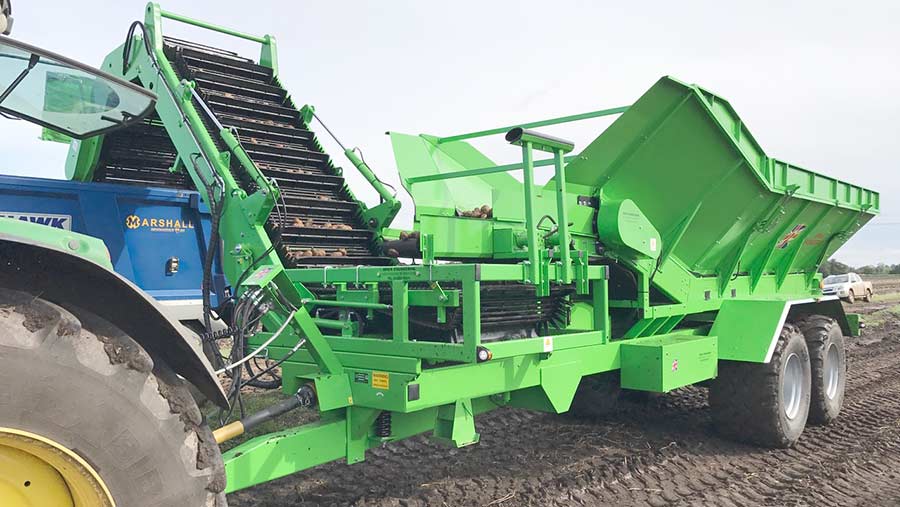 Stealing a march on its continental rivals, Doncaster-based Jones Engineering has already produced at least six of its Root Crop Chasers.
Stealing a march on its continental rivals, Doncaster-based Jones Engineering has already produced at least six of its Root Crop Chasers.
These are available with a 13cu m or 15cu m body and have a front-mounted elevator that can unload into a bulk trailer. Various different cleaning modules can also be added to suit various different crops and conditions.
As for the running gear, there’s a sprung drawbar, reinforced 250x150mm box-section chassis and a pair of 10-stud axles, with steering on the rear. To help keep the rig afloat, these are are fitted with chunky 710mm tyres.
There’s a pto-powered hydraulic pump on board with the option of fitting driven wheels, which two customers in Ireland have opted for.
Basic starting price is £68,000 and each machine is then tailored to the customer’s requirements.
Downs Geo DTX-18
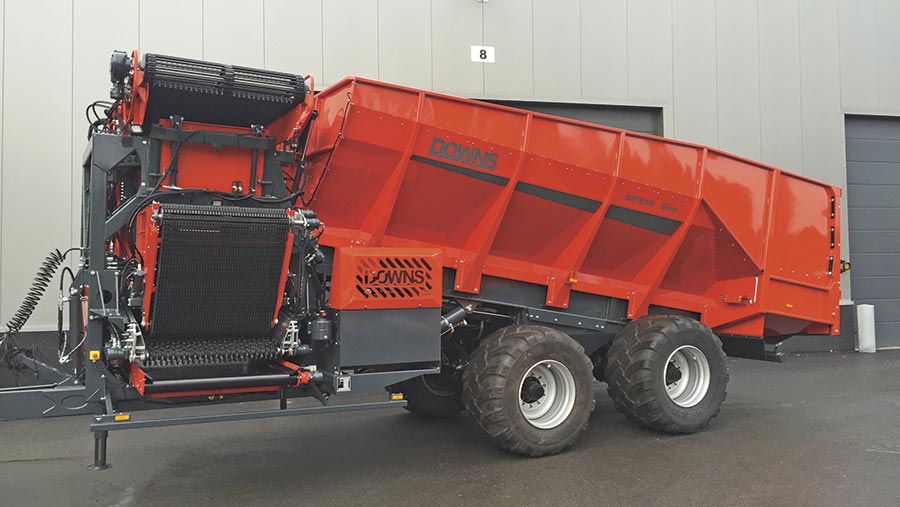 Downs, which is now owned by the French DuBrulle group, has opted for a dual-purpose machine that can either work as a chaser or be set up as a field loader.
Downs, which is now owned by the French DuBrulle group, has opted for a dual-purpose machine that can either work as a chaser or be set up as a field loader.
In standard chaser mode, the Geo DTX-18 looks like most of the other machines on the market with a front-mounted elevator and optional cleaner that can unload into a bulker.
However, by sliding the chassis backwards over the bogie, lowering the rear to the ground and opening the doors, it quickly converts to an in-field loader. This means trailers can tip into it for loading a bulker or filling boxes.
This all takes place in less than a minute and the operator can use a remote controller to direct all operations. A powered axle or tracks can be specified, too.
Brettmeister
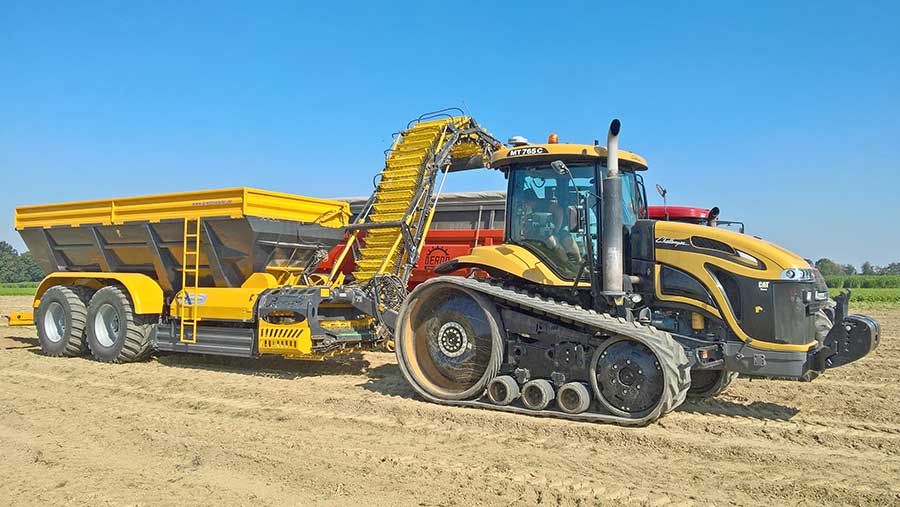 Brettmeister was one of the first companies to produce a potato chaser and its K3 model now has six years-worth of experience under its belt.
Brettmeister was one of the first companies to produce a potato chaser and its K3 model now has six years-worth of experience under its belt.
The K3 offers either a star or wave-form cleaner and its bunker comes in two sizes: 22 or 24cu m. It’s rated to travel at speeds of up 80kph on the road and comes with both a hydraulic drawbar and rear steering axle.
The firm’s control system allows two positions of the unloading elevator to be programmed, while a sensor will adjust the belt speed according to the load placed upon it. This prevents overloading, but also allows the driver to unload at the maximum speed.
Brettmeister has sold 15 machines in Europe so far and is currently searching for a UK distributor. Prices start at €90,000 (£78,720).
Hawe
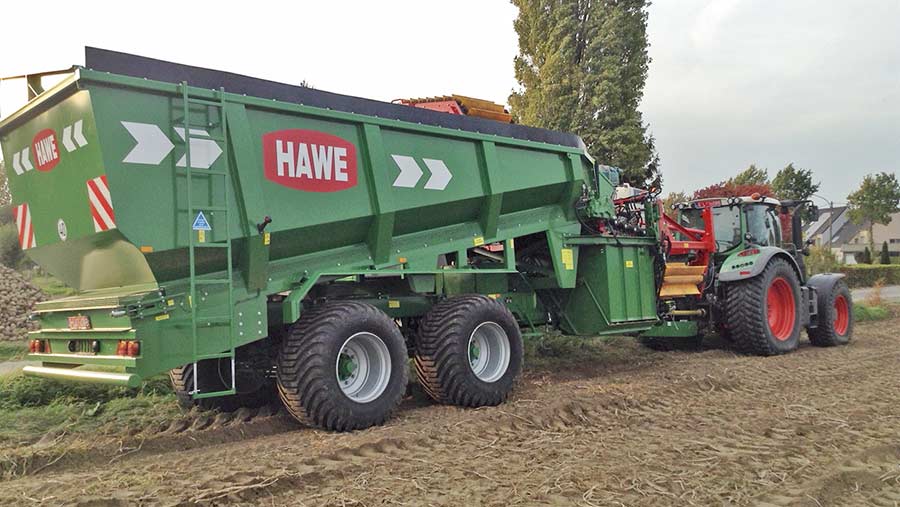 Hawe has based its KUW root-crop chaser on the same tried-and-tested chassis that it uses for its beet and cereals trailers.
Hawe has based its KUW root-crop chaser on the same tried-and-tested chassis that it uses for its beet and cereals trailers.
This can be specced with either two or three axles and has two capacity options of 22cu m and 24cu m.
The front-mounted cross elevator is 1.2m wide and can discharge at rates of up to 120t/hr. Maximum unloading height is 4.5m and the elevator folds in four places to transfer the crop as gently as possible.
Customers can also specify an optional set of cleaning rollers. These have a collection bunker below that will hold up to 2cu m of soil and trash. This can then be emptied back on to the field via two discharge flaps.
According to Hawe, roller distance can also be adjusted according to the crop and conditions. The KUW is suitable for most root veg, including potatoes, carrots, onions, beetroot and parsnips. Prices haven’t been confirmed.
Grimme
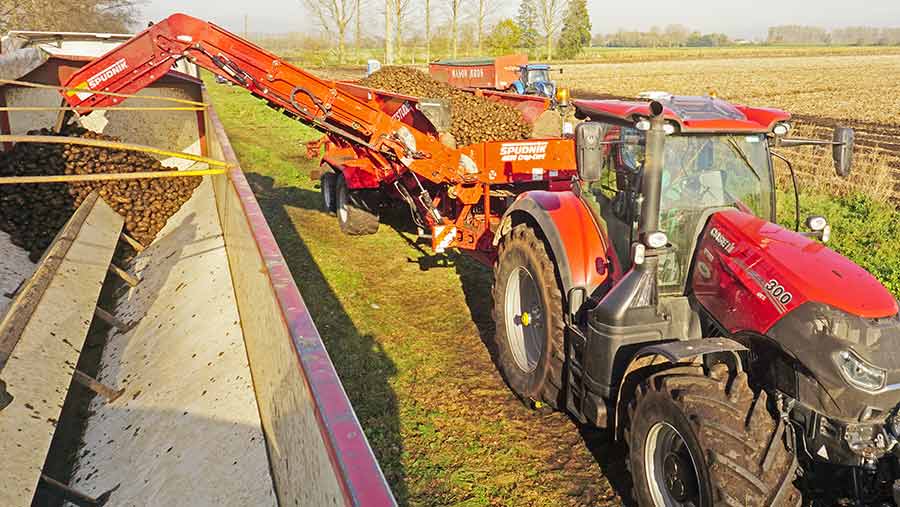 Grimme’s CropCart 4820 is a European-spec version of the machine built by its US subsidiary, Spudnik.
Grimme’s CropCart 4820 is a European-spec version of the machine built by its US subsidiary, Spudnik.
While the Yankee machine has a 35t capacity and wide track width, the 4820 sits on twin axles and has a maximum capacity of 20t.
The company built its first prototype in 2013 and since then makes around 25 CropCarts a year. The 4820’s shape is similar to Hawe’s offering, but is longer at 12m and there is no cleaning option.
A rear discharge door means the trailer can be used for conventional unloading or in confined spaces. Also in contrast to Hawe’s KUW, the floor uses a rubber belt. This means it can be used with sugar beet and there’s a conversion available so that it can handle grain too. Prices are yet to be confirmed.
|
Grimme |
Jones |
Hawe |
Downs |
Brettmeister |
|
|
Name |
Cropcart 4820 |
RootChaser |
KUW 2000 |
Geo DTX-18 |
K3 |
|
Height m |
3.75 |
3.8 |
3.9 |
3.6 |
3.75 |
|
Length m |
13.0 |
9.5 |
11.6 |
10.1 |
10.8 |
|
Width m |
2.9 |
3.2 |
2.9 |
3.0 |
2.75 |
|
Unladen weight t |
9.5 |
7.5 |
11.0 |
13.5 |
8.2 t |
|
Carrying Capacity cu m |
20 |
13 or 15 |
22 or 24 |
26 |
17 or 22 |
|
Unloading elevator width m |
1.1 |
1.2 |
1.2 |
1.2 |
1.1 |
|
Tyres |
650/65 R30.5 |
710 x 50 R26.5 |
800 x 45R26.5 |
750/45 R26.5 |
710/50R30.5 |
|
Brakes |
Air |
Air |
Air |
Air |
Air |

